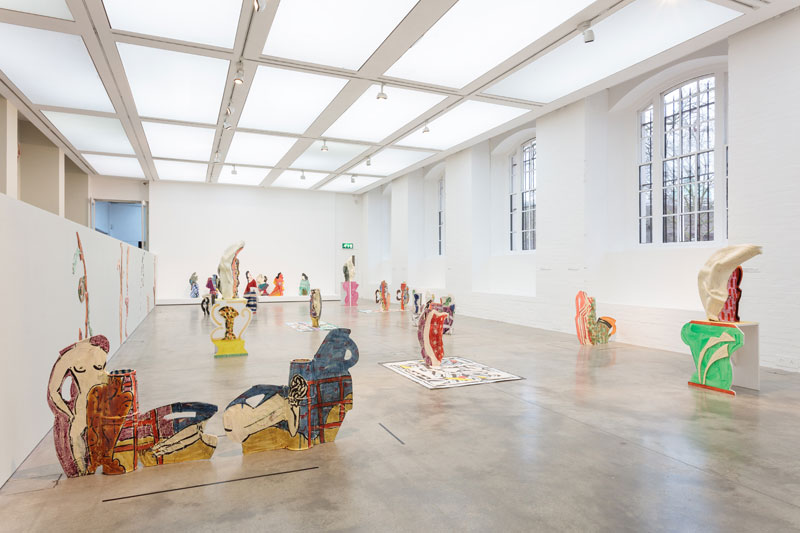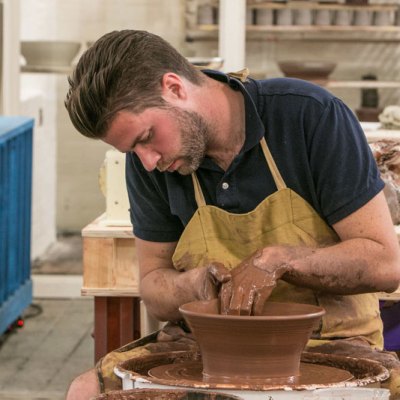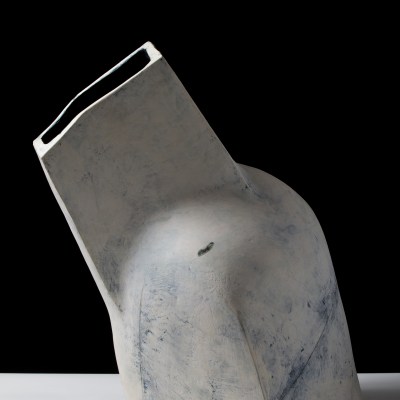At the ICA this spring, ceramics take centre stage. Among the exhibits is a group of what look to be geishas, gathered upon a raised platform, black chignon buns carefully crafted and offset by vibrant circular glazes of red, blue and yellow. Intricately patterned fabrics are draped over them like flowing kimonos to complete the scene. Created by octogenarian American artist Betty Woodman, the anthropomorphic Kimono Ladies (2015), along with the other clay characters in the show, are finally performing for a UK audience, this being Woodman’s first ever solo show in a UK institution.
Born Elizabeth Abrahams to Jewish parents in Connecticut in 1930, Woodman took her first pottery class at 16 and honed her craft in the 1950s at the School for American Craftsmen in Alfred, New York. More than half a century later, the world’s institutions are only just catching up. She had a retrospective at New York’s Metropolitan Museum 10 years ago: now, the ICA is presenting works created during the subsequent decade, bringing together vases, paintings and drawings in theatrical dialogue.
Installation view, ‘Betty Woodman: Theatre of the Domestic’ (3 February–10 April 2016), at the Institute of Contemporary Arts, London. Photo: Mark Blower

Woodman playfully approaches the idea of three-dimensionality within her practice. Traditionally, we associate ceramics with volume – vessels that can carry matter – but works such as Fra Angelico’s Room (2012), undermine this assumption. The large-scale installation of canvas, glazed earthenware, epoxy resin, lacquer and acrylic depicts a domestic interior, flat and lacking perspective. The room itself is painted on canvas in watery washes of colour – raspberry pink, sky blue, leaf green – and is offset by ceramics placed in front of it, and even mounted upon the canvas itself. The effect pulls pottery into the realm of painting or collage with the three-dimensional objects looking like caricatures of modernist cut-outs.
It was during a visit to Florence – the site of one of Fra Angelico’s masterpieces – in 1951 that Woodman became truly inspired, surrounded by what she describes as piles of rubble and hope. Today, she owns a farmhouse in a Florentine suburb, and the influence of fervent Italian Renaissance colours and Majolica pottery glazes continues to be seen in her work. She has found further inspiration in periods and methods as far ranging as Roman, Greek and Etruscan pottery, Japanese Oribe ware, Chinese Tang dynasty ceramics and 18th-century porcelain, but her recent work is clearly rooted in the joie de vivre of avant-garde painters such as Pierre Bonnard and Henri Matisse. Wall-mounted ceramics have floral, ivy-like tendrils and undulating whiplash curves reminiscent of those in Matisse’s domestic interior, Harmony in Red (1908). In Vase and Carpet: Alba (2015), ceramic vessels rest upon a colourful combination of canvas, earthenware and paint, arranged into patterns like a decorative rug. Her drawings in particular recall the work of Matisse; strong black lines drawn over bright colours with expert precision.
Fra Angelico’s Room (2012), Betty Woodman. Photo: Mark Blower

Woodman’s work breaks the boundaries of form; two-dimensional painting merges with three-dimensional vessels, interchangeable. The decorative design of ceramics is combined with a painterly sensibility to show us that clay can challenge and excite as much as the next medium.
‘Betty Woodman: Theatre of the Domestic’ is at the ICA, London, until 10 April.



